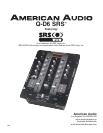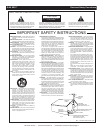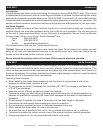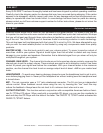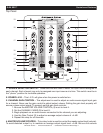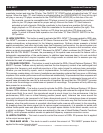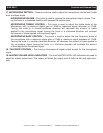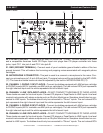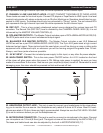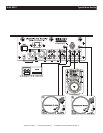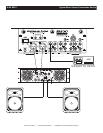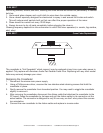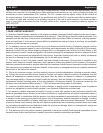
Q-D6 SRS™ Controls and Features Cont.
control is always set to zero before turning the unit on.
5. CUE LEVEL VOLUME CONTROL - This knob is used to adjusts the headphone volume output
level. Turn the knob in a clockwise direction to increase the headphone volume.
6. CUE MIXING CONTROLLER - This knob selects the channel for monitoring. The monitor signal
comes from the Prefader. This means it will not be affected by the channel faders. You can monitor
each channel individually. Connect your headphones to the HEADPHONES JACK (33). Turn the CUE
MIXING CONTROL to CUE and select the desired channels with the Cue buttons. When you turn the
CUE MIXING CONTROL to PGM (PFL switches without function), you can cue the output signal of the
mixer. If the CUE MIXING CONTROL is set to the center position, you can cue both the channel signal
you selected and the output signal. With the CUE LEVEL control, you can adjust the phones volume
without changing the output signal.
7. CHANNEL EQUALIZER - All of the channels include a three-band signal EQ. These controls are
used to increase or decrease the LOW’s, MID’s, and HI’s of the output signal.
CHANNEL TREBLE CONTROL - This knob is used to adjust the treble levels of a channel
allowing for a maximum treble gain of 9dB or maximum decrease of -26dB. Turning the knob
in a counter-clockwise direction will decrease the amount of treble applied to a channel signal,
turning the knob in a clockwise direction will increase the amount of treble applied to a channel
signal.
CHANNEL MIDRANGE CONTROL - This knob is used to adjust the midrange levels of a
channel allowing for a maximum midrange gain of 9dB or maximum decrease of -26dB.
Turning the knob in a counter-clockwise direction will decrease the amount of midrange app-
lied to a channel signal, turning the knob in a clockwise direction will increase the amount
of midrange applied to a channel signal.
CHANNEL BASS CONTROL - This knob is used to adjust the low frequency levels of a
channel allowing for a maximum bass gain of 9dB or maximum signal decrease of -26dB.
Turning the knob in a counter-clockwise direction will decrease the amount of bass applied to
a channel signal, turning the knob in a clockwise direction will increase the amount of bass
applied to a channel signal.
8. CUE BUTTONS - These buttons are used to activate a channels “CUE” mode. A red LED on
the Cue button will glow when that channels cue mode is activated. Cue mode will send a channels
incoming signal to the headphones. The cue level is adjusted by the CUE LEVEL VOLUME KNOB
(5). Be sure the cue level is set to minimum before putting a pair of headphones on. Be sure the CUE
MIXING KNOB (6) is turned to the “CUE” position to hear the selected channel source.
9. CHANNEL FADER - These faders are used to control the output signal of any source assigned to
its particular channel.
10. FEATHER FADER PLUS CROSSFADER - This fader is used to blend the output signals of chan-
nels one and two together. When the fader is in the full left position (channel 1), the output signal of
channel one will be controlled by the master volume level. The same fundamentals will apply for chan-
nel two. Sliding the fader from one position to another will vary the output signals of channels one and
three respectively. When the crossfader is set in the center position, the output signals of both the
channels one and channels two will be even. The Channel three fader will work when the crossfader is
any position.
11. Q-START ON/OFF SWITCH - This function works in conjunction with a compatible American
©American Audio® - www.americanaudio.us - Q-D6 SRS™ Instruction Manual Page 8



